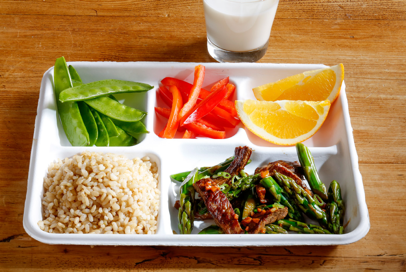 May 24, 2018
May 24, 2018
By Moira O’Neill, JD
Moira O’Neill is a Research Scientist, Institute of Urban and Regional Development, and Senior Research Fellow, Center for Law, Energy & the Environment.
Photos by Center for Ecoliteracy.
Why does school meal reform matter, and why so much in Oakland?
You can not assume that children will eat whatever is put in front of them. Nor can you assume that whatever food is put in front of the child will contribute to their well-being. Nationally, school meal reform matters because schools are a key setting for any public health strategy intended to address childhood obesity and improve healthy eating.1 School settings are also critical to addressing food insecurity—the average student consumes between a third and half of their daily calories at school.2
Locally, over 70% of Oakland Unified School District’s students have qualified for Free or Reduced Priced Lunch (FRL) since 2009, which means that they live in low income households. Some of these students are at risk for food insecurity. Recognizing that persistent risk of hunger and poor health outcomes impact educational outcomes, the Oakland Unified School District (OUSD) has worked for years to improve its school lunch program to better meet the needs of its most vulnerable students. In 2010, OUSD partnered with the Center for Ecoliteracy to launch Rethinking School Lunch Oakland (RSLO). RSLO is built on a planning framework that the CEL created in 2005. It envisions complete school meal reform through a ten-pronged approach. As a member of a research team interested in what local institutions can do to serve vulnerable groups, this work in Oakland presents a compelling case study.
Increasing student consumption of healthy food requires that schools provide, as as starting point, “healthy” and “tasty” food. But this presents complex challenges to departments that are heavily regulated, must be financially self-sustaining, and are often siloed from other school district operations. RSLO’s systems change approach to school meal reform is premised on the notion that no one intervention alone can increase student consumption of healthy food.3 Among the many pathways to change, the design incorporates integrating school garden programs into the school curriculums to connect students to growing fruits and vegetables4 and integrating nutrition education into the school curriculum.5 During the first podcast episode, you can hear how excited the students at Cleveland Elementary are to participate in that site’s Ecoliteracy program and how appreciative parents are that their students are learning about food systems and healthful food.

Rethinking School Lunch Oakland is about changing meals from this…
RSLO does not end with curriculum improvements. It incorporates health campaigns to promote new food items6 and using salad bars to encourage consumption of fruits and vegetables.7 RSLO also attends to procurement practices, considering the relationship between school meal programs and the local food system and local economy, the fiscal constraints most school districts are operating within, and the professional development needs of staff and personnel shifting to a new model of school food operations. In sum, it is complete in its approach to school meal reform.

… to this.
What does it take to implement school meal reform in Oakland?
Broadly, changing Oakland’s school meal program requires political will, parent involvement, financing, and time. Specifically, in Oakland a 2011 feasibility study found that implementing RSLO required a major infrastructure investment because inadequate facilities and equipment prevented school meal program innovations in nearly every pathway. The solution? Build a Central Kitchen, Instructional Farm, and Education Center. The conceptual illustration provided by the architects illustrates the community development aspects of thiswork (a major draw for the research team):
Oakland financed this project through a bond measure that 84% of the electorate supported. But while the key facility is being built, the work on improving school meals still continues. One of the most significant milestones CEL and OUSD achieved during the wait includes important menu development and marketing effort: they collectively launched “California Thursdays” on Earth Day 2013 to provide students city-wide with a single scratch-cooked meal sourced from fresh California ingredients. During the second episode, you can how hard the Nutrition Services department in Oakland is working to provide fresh food to schools across the city, and how much they care about what they serve their students.

Children study a carrot just pulled from the ground, so they can learn how food really grows.
Implementing a California Thursdays menu and promotional change is offered as an achievable first step for school districts interested in school meal innovations. Since its launch in Oakland Unified, California Thursdays has grown from a single participating district (Oakland) to 71 in 2017 in 28 counties across the state. (This year, the network will grow to 88districts.) As a research team, this tells us that the work in Oakland is replicable and scalable. The 2017 UC Sustainable Agriculture Research and Education Program Policy Brief “Strengthening California Farm to School Programs” identified California Thursdays as a program that can “help increase local procurement by raising awareness and promoting healthy, local foods to parents and children.8 Despite the hurdles of implementing systems change to school food in Oakland, what started in Oakland continues to spread across the state!
What can you do to support this work?
If you are interested in supporting the work in Oakland, you can consider giving directly to this work through the Oakland Education Fund. Oakland Unified is committed to feeding all of its students–regardless of their ability to pay. So your contribution can help cover that cost, or you could contribute to supporting the garden curriculum going on at school sites. You can also support the non-profit partners working within Oakland Unified, and other districts statewide, to improve the quality of school food. Some of those partners, for example, include the Center for Ecoliteracy, and the Center for Good Food Purchasing.

A menu tasting session at West Oakland Middle School
If you live outside of Oakland, and are interested in seeing this work occur within your home district, consider reaching out to the Nutrition Services department within your school district to find out what they are already doing. Do they participate in any Farm to School programming? If you are in California, are they part of the California Thursdays network? You can also scan for opportunities to support this work through public financing mechanisms–like bond measures or Soda Taxes. These are important to financing the infrastructure and equipment investments needed for operational shifts, and require the electorate’s support to approve them. Do you have relevant expertise? You can contact the school district and see if they need volunteers, for gardening or related programs. You make the difference.
References:
1 Story, M., Nanney, M. S., & Schwartz, M. B. (2009). Schools and Obesity Prevention: Creating School Environments and Policies to Promote Healthy Eating and Physical Activity. Milbank Quarterly, 87(1), 71-100. doi:10.1111/j.1468-0009.2009.00548.x
2 Briefel, R. R., Crepinsek, M. K., Cabili, C., Wilson, A., & Gleason, P. M. (2009). Research: School Food Environments and Practices Affect Dietary Behaviors of US Public School Children. Journal of the American Dietetic Association, 109(Supplement), S91-S107. doi:10.1016/j.jada.2008.10.059
2 Heim, S., Stang, J., & Ireland, M. (2009). A Garden Pilot Project Enhances Fruit and Vegetable Consumption among Children. Journal of the American Dietetic Association, 109(7), 1220-1226. doi:https://doi.org/10.1016/j.jada.2009.04.009; Blanchette, L., & Brug, J. (2005). Determinants of fruit and vegetable consumption among 6-12-year-old children and effective interventions to increase consumption. Journal of human nutrition and dietetics.
3 Gase, L. N., McCarthy, W. J., Robles, B., & Kuo, T. (2014). Student receptivity to new school meal offerings: Assessing fruit and vegetable waste among middle school students in the Los Angeles Unified School District. Preventive Medicine, 67, Supplement 1, S28-S33. doi:https://doi.org/10.1016/j.ypmed.2014.04.013
4 Davis, J. N., Ventura, E. E., Cook, L. T., Gyllenhammer, L. E., & Gatto, N. M. (2011). LA Sprouts: A Gardening, Nutrition, and Cooking Intervention for Latino Youth Improves Diet and Reduces Obesity. Journal of the American Dietetic Association, 111(8), 1224-1230. doi:https://doi.org/10.1016/j.jada.2011.05.009 ; Gatto, N. M., Ventura, E. E., Cook, L. T., Gyllenhammer, L. E., & Davis, J. N. (2012). LA Sprouts: a garden-based nutrition intervention pilot program influences motivation and preferences for fruits and vegetables in Latino youth. Journal of the Academy of Nutrition and Dietetics, 112(6), 913-920.
5 Guthrie, J. F., & Buzby, J. C. (2002). Several Strategies May Lower Plate Waste in School Feeding Programs. FoodReview, 25(2), 36; Blanchette, L., & Brug, J. (2005). Determinants of fruit and vegetable consumption among 6-12-year-old children and effective interventions to increase consumption. Journal of human nutrition and dietetics.
6Baranowski, T., Davis, M., Resnicow, K., Baranowski, J., Doyle, C., Lin, L. S., . . . Wang, D. Q. T. (2000). Gimme 5 fruit, juice, and vegetables for fun and health: Outcome evaluation. Health Education & Behavior, 27(1), 96-111. doi:10.1177/109019810002700109
7 Adams, M. A., Bruening, M., Ohri-Vachaspati, P., & Hurley, J. C. (2016). Research: Location of School Lunch Salad Bars and Fruit and Vegetable Consumption in Middle Schools: A Cross-Sectional Plate Waste Study. Journal of the Academy of Nutrition and Dietetics, 116, 407-416. doi:10.1016/j.jand.2015.10.011; Slusser, W. M., Cumberland, W. G., Browdy, B. L., Lange, L., & Neuman, C. (2007). school salad bar increases frequency of fruit and vegetable consumption among children living in low-income households. Public health nutrition(12).
8 Wade, J., & Feenstra, G. (2017). Strengthening California Farm to School Programs. In U. S. A. R. a. E. Program (Ed.): UC Sustainable Agriculture Research and Education Program